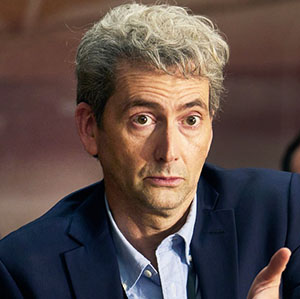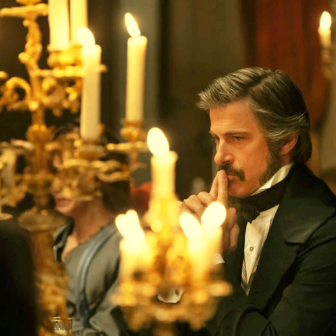There’s no sign of the crime rate dropping on TV, where the best efforts of leading production teams are dedicated to keeping it buoyant. On its Crime Time play-on-demand site, SBS provides a well-curated selection of no fewer than thirty-nine series from Canada, Britain, Romania, Argentina, France, Iceland and, of course, Scandinavia. You’d have to play some pretty serious catch-up to get across this lot.
Should we be concerned about the state of a collective psyche that knocks back cocktails of sadism, abduction and random homicide at such a rate? The comfort-zone theory of crime fiction gives some reassurance: it’s an opportunity to take an imaginative journey through the heart of darkness, knowing that it will all come right in the end. The problem is, there is no end. There’s always another series, and the last episode of each one typically leaves us with a muddy state of affairs, fraught with moral compromises and unsettled scores.
Does some sort of repetition compulsion lie at its heart? Genre fiction is all about the reworking of stock elements, and Nordic noir, the most powerful subgenre of crime TV to have emerged in recent years, is nothing if not heavily formulaic. More often than not, the plots revolve around the need to rescue someone strapped to a chair in a bunker being given a seriously bad time to a soundtrack that might have been created on a demolition site.
Here, there’s no such thing as a one-punch death: the average cop can take a good half dozen full-force punches to the head, followed by a dozen kicks in the ribs when he or she is down, and be back on the case a few hours later with a couple of judiciously placed scars on the face. The living body is impossibly resilient, and the state of the corpse in the autopsy room testifies to what it takes to defeat it. The camera lingers in close-up over deep weals in the flesh, burned and blackened extremities, savage facial injuries. Designer wounds have become a special branch in the make-up department.
The Stockholm-based series Before We Die incorporates most of the stock elements, but also displays the deeper strengths of the Scandinavian tradition, which lie in a serious commitment to dramatic narrative. Hour-long episodes provide an acid test for the writers’ capacity to sustain increasingly complex situations and plotlines on their own terms.
Marie Richardson gives a gritty performance as the detective at the centre of it all, the mother of the wayward youth who gets involved in the mobster wars dominated by the Mimicas, a Serbian family from Krajina. Here, the series adheres to another convention — that villains are from Eastern Europe or the Middle East, and the forces of law and order are represented by Swedes or Danes. But there is an excellent role for Alexej Manvelov as Davor, the head of the Mimica family, whose mesmeric eyes and relaxed menace give him an authority equal to that of anyone in law enforcement.
Tensions run in all directions. The dialogue is scripted like modernist chamber music, all broken rhythms and terse, unfinished phrases. For the Mimicas, trust is a heavy-duty business, set about with tests and cross-checks, while the police team is riven by doubts and betrayals.
The writing may be the primary determinant of quality in a crime series, but the overall impact depends on a synergy between script, editing and cinematography. Before We Die doesn’t feature extravagant location shooting, but the photography is subtle and impeccably judged. Scenes set in a bar, a bus or the offices of the police department gain visual interest from lighting and focus. Skilled, unassuming work of this kind builds credibility, anchoring the bizarre chain of events in an everyday world.
The Killing (2007) and The Bridge (2011) — the defining works of Nordic noir on television — displayed a capacity to introduce gothic horror into a setting of sustained social realism. What’s sinister in this genre has less to do with violent deeds than with the psychological tangles that tighten around them.
The atmospherics of place are another core element. As the growing international audience has swelled production budgets, the lure of spectacular northern scenery has intensified. Arctic locations were the real stars of the first series of Fortitude, in spite of a cast that included Michael Gambon, Stanley Tucci and The Killing’s Sofie Gråbøl. The series started out well enough, but had lost the plot by episode four. It was as if the commitment to psychological realism couldn’t stand the location test and the production team felt the need to match the extreme landscapes with extravagant events at every turn.
Series two heads deeper into X Files territory, starting off with a monstrous figure trekking off into the snow, greeting the crimson sky with an echoing primal howl. From there we cut to the supermarket, where the Norwegian governor (Gråbøl) is doing the shopping. Normality? Of a kind.
The pharmacy assistant quotes Yeats’s “Second Coming”: “The centre cannot hold.” She’s studying for her EngLit exams, she says brightly, as a commotion breaks out in aisle two, where one of the locals turns mad axeman in response to a dispute with the manager. In a moment that’s pure Fargo, a slightly built female cop bursts in, gun at the ready, and it all winds back to business as usual in a more than slightly crazed small town. Next thing we’re in the pub, where a mad old Scotsman is telling tales of the apocalypse. He heads out into the night, raising his arms in salute to the “blood aurora,” as a shadowy figure approaches from nowhere. It’s not hard to guess who’ll be the next gruesome corpse on the mortuary slab. Supernatural influences are at work.
The trouble with Fortitude is that it is all over the place in genre terms: equal parts X Files, Fargo, Twin Peaks and Alien. It attempts a mythic level and a sense of poetry, but the mythology is hackneyed (monsters in the ice wilderness) and the poetry is borrowed from sources that are too obvious.
But perhaps Nordic noir itself has peaked. Hubris is certainly a problem: those who made their reputations in earlier series are reaching out in too many directions. They want it all — poetics, mythos, serious human drama, the thematics of planetary crisis. All this comes to a head in Midnight Sun (2016), directed by Måns Mårlind and Björn Stein, two of the lead writers on The Bridge. Filmed in the Abisko national park in the Arctic Circle, this is one of the most expensive series ever created for television.
In scenic terms, Midnight Sun is a knockout. The action takes place in summer, when twenty-four-hour daylight presents a strange twist on the conventional atmospherics of “noir” and the valleys are patched with the vestiges of winter snow. Helicopters feature strongly in the plot, and provide opportunities for panoramic footage in every episode.
There’s a blend of fact and fiction in the treatment of setting. The town of Kiruna, at the heart of the story, is being relocated because subterranean instabilities are sending huge cracks running through its centre. (This actually was happening as the series was being filmed.) Tensions between the indigenous Sami people of Lapland and townspeople working for the mining companies have widespread reverberations in Swedish culture, and the series creators have drawn high praise with scenes featuring a genuine Sami shaman.
With so much going for it, how could the story fail? In commercial terms, the series has been successful enough, with strong international distribution and generally favourable reception. But with some critical distance, now, from the hype surrounding its release, it’s hard to avoid seeing the problems. Like Fortitude, it attempts a poetic dimension. Occasionally this works, as in a scene where the female detective Kahina Zadi (Leïla Bekhti) wakes in broad daylight at who knows what hour of the “night” to hear a strange rattling noise. Half mesmerised, she goes out to track its source and sees, wandering between the trees, a white reindeer ritually decked out with scarlet ribbons.
But it takes an exceptional creative vision to hold a poetic or mythic dimension in place. The creators of Twin Peaks, Fargo and Game of Thrones manage to do this, but imitators should beware. Ultimately, Midnight Sun is a failed story overloaded with horrors and portentous events. On a human level, it just doesn’t get anywhere. The secret of the thriller genre is that the most compelling scenes are typically not those in which some prodigiously horrible act of violence is committed, but rather those of the detective behaving badly.
Zadi, the French detective called in to find out how a French citizen has met a particularly grizzly end tied to a helicopter propeller, keeps her cool. She’s beautiful, softly spoken, always intelligent — and boring. She made me long for the hissy fits and bossy obtuseness of Saga in The Killing. Her Swedish counterpart, Anders Harnesk (Gustaf Hammarsten), spends most of his time explaining to her what has happened, since she always seems to have been off dealing with an emotional crisis (concerning, of course, a young adult son). When the detectives have to keep telling each other the plot, the writers have lost it.
If the Scandinavians are losing their edge, they’d better watch out, as some serious rivals are encroaching on the scene. I haven’t watched all the offerings on the SBS Crime Time site, and will report back on more of them at a later date, but my pick of the bunch so far is Cromo, a series released in 2015 by TV Pùblica, the Argentine public television network.
Cromo, too, has locations to die for (or in?). The first episode alternates scenes from a storm in the Antarctic with the slow tracking of a woman in a canoe, travelling up a remote creek in the tropical swamplands of Corrientes. A few days later, she’s found dead, apparently drowned, and two men, both emotionally connected to her, return to Argentina to bury her. From here, the story unfolds slowly. Perhaps the death wasn’t an accident. It may have to do with the environmental research she was conducting, and the vested interests she was threatening. Twists and turns in the plot are managed through some deft psychological profiling on the part of the series creators, Lucía and Nicolás Puenzo (a brother-and-sister team). It’s about personalities and motives rather than horrors.
As I write, the release of the Paradise Papers is reverberating around the news world. But no matter what the evidence, no matter what extraordinary investigative persistence may be behind this, will it actually lead to prosecutions? Criminal behaviour is not always out there in the wilds of Crime Time. Sometimes it’s deeply embedded in our society and, as part of our system, not always subject to justice and prosecution. Could it be that this is why we are so obsessed with the figure of the detective, fighting a relentless crusade against bad guys who do things no one can possibly overlook? ●




